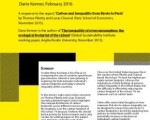Reducing inequality and carbon footprints within countries
Dario Kenner (Why Green Economy?) February 2016
This is my response to the report Carbon and inequality: from Kyoto to Paris by Thomas Piketty and Lucas Chancel (Paris School of Economics, November 2015)
To date there has been a lot of focus on comparing the size of countries’ greenhouse gas emissions. Interest is now growing in exploring the links between individual’s carbon footprints and today’s extreme inequality within countries.
Thomas Piketty and Lucas Chancel’s report highlights the unequal distribution of carbon footprints across different income groups. For example, they estimate that in many countries the richest 1% have a much higher carbon footprint per person than the income deciles below them (see their methodology on page 25 and download their data set). Oxfam published similar findings in December.
Piketty and Chancel estimate that the country where the people making up the richest 1% have the highest carbon footprints per person is in the United States. They estimate that in 2013 the average emissions per person of the richest 1% (3.2 million people) was around 318 tonnes of CO2e. In comparison the average emissions per person of the poorest 10% (around 31 million people) was around 3.6 tonnes of CO2e (see the table below).
| United States | Income deciles |
Population of income decile (million) |
Consumption based CO2e emissions per capita |
| Poorest | 10% | 31.6 | 3.6 |
| 10% | 31.6 | 7.1 | |
| 10% | 31.6 | 9.7 | |
| 10% | 31.6 | 12.2 | |
| 10% | 31.6 | 14.8 | |
| 10% | 31.6 | 17.6 | |
| 10% | 31.6 | 21.1 | |
| 10% | 31.6 | 25.6 | |
| 10% | 31.6 | 32.6 | |
| 9% | 28.4 | 58.5 | |
| Richest | 1% | 3.2 | 318.3 |
Source: Piketty and Chancel, 2015.
One reaction to their finding is that consumption based emissions should be more evenly distributed within the population. However, the goal can no longer be just to resolve carbon inequality because governments have recently committed to reducing their total greenhouse gas emissions at the COP21 climate conference in Paris.
Piketty and Chancel’s data shows that in other high emitting countries such as Australia, Canada, China, France, Germany, Mexico, India, Indonesia, Russia, Saudi Arabia, Japan and the United Kingdom the richest 1% (in each of these countries) have much higher average per capita CO2e emissions.
The scale of action needed to tackle climate change requires reductions in carbon footprints across society. However, I believe Piketty and Chancel’s data highlights that the immediate priority should be to target the richest 1% because they have the highest greenhouse gas emissions per person in many countries.
This will not be straight forward in a context of extreme inequality. For example, while carbon taxes would mean the richest 1% had to pay more to consume fossil fuels, they might be able to ignore a carbon tax if it was not high enough because they could use the income generated from their existing (and future) wealth to cover this cost.
Given that climate change affects all of us there needs to be an open public debate, with the participation of experts and non-experts, about what will make the richest actually reduce their carbon footprints. One policy that might work is a frequent flyer levy (research shows that in the United Kingdom 15% of the population took 70% of flights in 2013).
Factoring climate change in to policies that aim to reduce inequality
There is growing public pressure for governments to take action to reduce extreme inequality. This pressure is only likely to continue given that according to Oxfam’s latest research the richest 1% now hold more wealth than the poorest 3.6 billion people combined. So at some point governments may introduce policies to redistribute wealth from the richest to the rest of the population.
How would redistribution affect a person’s carbon footprint? Would it increase because they used their additional income to purchase carbon intensive goods and services? Or would they now be able to afford “green” goods and services? Or would they save their money and how would this affect their carbon footprint?
These are the kind of questions that we urgently need to find answers to. Otherwise tackling inequality might actually contribute to people increasing their carbon footprint via their direct emissions (e.g. they travel more by car and planes, they use more energy in their homes) and indirect emissions (e.g. they purchase more electronic goods, clothing, meat and imported food).
More research is needed on how different policies to reduce inequality affect an individual’s carbon footprint to ensure that future policies can be designed to, as far as possible, factor climate change in to policies that aim to reduce inequality.
 Read full article
Read full article
Published by the Global Sustainability Institute, Anglia Ruskin University
————————————
Dario Kenner is the author of The inequality of overconsumption: the ecological footprint of the richest (Global Sustainability Institute working paper, Anglia Ruskin University, November 2015)
Read working paper
Read responses to the working paper
Alex Cobham
Director of research at the Tax Justice Network, and a visiting fellow at King’s College London
Are some people consuming too much?
Katherine Trebeck
Global Research Policy Adviser at Oxfam
 Climate crisis? We can’t solve it without tackling inequality too
Climate crisis? We can’t solve it without tackling inequality too
Richard Dyer
Campaigner in the Economics and Resources Programme, Friends of the Earth England, Wales and Northern Ireland




Pingback: To Stop Climate Change, Don’t Just Cut Carbon. Redistribute Wealth | The Reader Magazine
Pingback: To Stop Climate Change, Don’t Just Cut Carbon. Redistribute Wealth. - NationofChange | Progressive Change Through Positive Action
Pingback: The rich are super-polluters, and carbon taxes should be paired with other policy instruments to redistribute wealth and reinvest in clean energy | The Global Catholic Climate Movement
Pingback: To Stop Climate Change, Don’t Just Cut Carbon. Redistribute Wealth.
Pingback: Carbon Inequality & Politics | From Poverty to Power